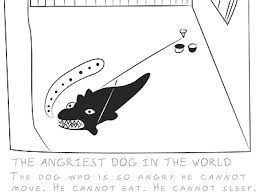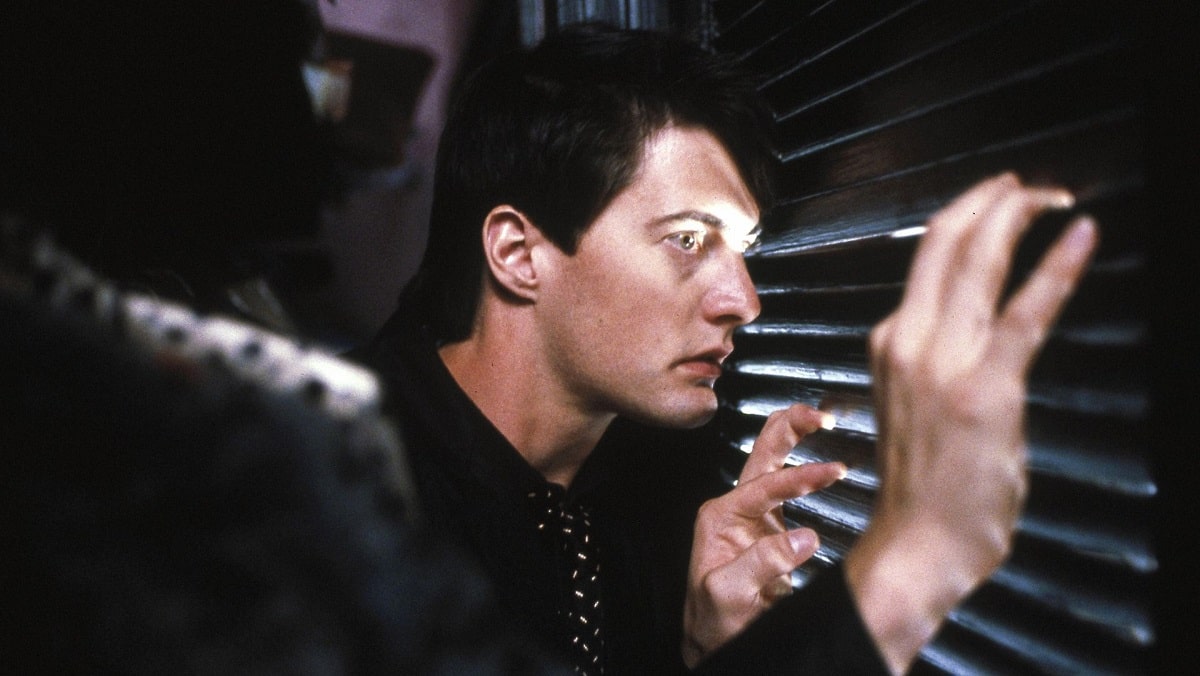[In a life full of quirky projects, David Lynch’s comic strip “The Angriest Dog in the World” still stands out. Similar to Dinosaur comics, a single strip, drawn by Lynch, provided a palette for a weekly dose of philosophy and weirdness, running from 1983-1992, when Lynch must have become too busy to continue. The strip ran in the LA Reader overlapping some of Lynch’s rise to tremendous fame, alongside Matt Groening’s Life in hell and Lynda Barry’s Earnie Pook’s Comeek. Truly the golden age of alternative comic strips. With all the attention to and tributes to Lynch’s work after his death, I was lucky to run across (on FB) this account of working on “The Angriest Dog in the World” from Dan Barton, who was editor at the Reader back in the day. Shared with Barton’s permission, yet more proof of the wonder that was David Lynch the man and creator. – -Heidi MacDonald]

By Dan Barton
Again within the eighties, I used to be the editor of another newspaper printed right here in Southern California, the Los Angeles Reader. I used to be younger, inexperienced, and in over my head greater than just a bit bit. On a miniscule funds I handled mega abilities each day. Some who went on to higher glory, some didn’t. Extra on that one other time.
One of many common options within the Reader was a comic book strip referred to as “The Angriest Canine within the World” by . It was comprised of 4 panels, hand-drawn by Lynch at one time. It featured a growling canine tethered outdoors a house, together with his proprietor unseen apart from captions that drifted out a window.
Lynch had submitted the artwork just a few years earlier than I arrived. Each week he referred to as within the captions by phone. They diverse every strip, however the artwork stayed the identical. (This was pre-fax, pre-email, pre-office laptop.)
I’ve heard from a former Reader staffer about how Lynch would name in each week from the set of “Dune,” the telephone service in Mexico making the calls full of static.
“The Canine,” as we referred to as the strip across the workplace, was one other characteristic of the Reader that was a part of its perpetual quirkiness: one thing that will solely exist in that exact publication.
 As soon as I acquired the job of editor, it was Lynch who referred to as me each week with the captions. Often, he delegated the duty to an assistant, however for a few 12 months and a half, I used to be on the telephone with David Lynch each week.
As soon as I acquired the job of editor, it was Lynch who referred to as me each week with the captions. Often, he delegated the duty to an assistant, however for a few 12 months and a half, I used to be on the telephone with David Lynch each week.
The intercom on my desk would buzz, and the receptionist would say: “It’s David Lynch” as if the pizza had simply arrived for lunch. I’d choose up the telephone and we might trade pleasantries after which he would say “I acquired one other Canine for you.” I’d write down the captions after which he’d log off. Our conversations weren’t very lengthy—at first.
Typically we chatted about his movies. That was how I first noticed his model of Dune. I rented it (on VHS, imagine it or not), watched it at dwelling in my condominium in Santa Monica, after which talked to him about it the following time he referred to as. He was not one to dwell on the previous; he was busy making one other movie on the East Coast. However . . . he expressed remorse that the particular results didn’t fairly convey what he was going for. I as soon as requested him what the noxious black liquid was that Kenneth McMillan as Baron Harkonnen doused himself with within the midst of a (actually) flying killing rage. His reply was easy in his significantly lilting approach of talking: “I don’t know,” he mentioned, “but it surely does one thing to him, doesn’t it?”
At one level, somebody in higher administration steered Lynch not receives a commission for doing the strip. “See if he’ll do it at no cost,” I used to be instructed. Lynch was paid a pittance: a mere twenty-five {dollars} per week. For some cause, this was made this a specific level of rivalry.
After I ran this by Lynch, he chuckled. “No,” he mentioned. “You pay for it. It isn’t free.” I bear in mind administration’s disappointment on listening to this. I used to be blamed. I hadn’t requested Lynch proper.
The excessive level of my telephone calls with Lynch got here when he invited me to a screening. He had instructed me he was on the town engaged on his newest movie: modifying, scoring, all of the duties of post-production. Then, at some point he requested if I wished to see it. I mentioned after all. The following week, an assistant referred to as again with a date and time for a screening. When he referred to as in that week’s strip I requested if he was going to be there. We had by no means met in individual. He mentioned no, however he wished to know what I considered the movie after I noticed it.
The screening was on the De Laurentiis Leisure Group Studios. I bear in mind the screening room was not even half full. There have been statues of a gold lion on either side of the display. A gold lion was the icon of the corporate. I feel the screening room was on Sundown Boulevard, however I’m not positive.
I introduced a date. The lights went dim, and the film unspooled.
The movie was “Blue Velvet.”
I noticed it months earlier than it was launched, earlier than anybody knew something about it. Now I noticed I will need to have been one of many first folks within the media, probably the nation to see it in its completed type.
It was a mysterious, magical film expertise, one I’ll always remember. Later that week when David referred to as in to present me the captions for that week’s strip, I raved about it to him with real enthusiasm. In his David Lynch approach, he obtained every of those gushing compliments with a easy swish “Thanks.” After I requested him what the mysterious gasoline was that Dennis Hopper inhaled from a canister by a masks that despatched him right into a violent mood, he gave me the identical reply I’d heard earlier than: “I don’t know,” he mentioned, “but it surely does one thing to him, doesn’t it?”

I left the Reader later that 12 months for a quite simple cause; I had bought my first novel. I obtained an advance based mostly on a top level view and pattern chapters. It was sufficient to stay out on the seaside and write to my coronary heart’s content material for at the least six months.
I bear in mind my final telephone name with David. I instructed him what had occurred and he perked up on the information. “Oh,” he mentioned. “It’s important to go do this.” Then in farewell, he mentioned: “Good working with you.”
I bumped into him yet one more time, in a grocery store in Westwood. He was with Isabella Rossellini, who had been so memorable in “Blue Velvet.” I approached him and launched myself. He smiled and mentioned it was good to fulfill me in individual. In farewell he grinned, winked, and mentioned, “Good luck to you, Dan.”
I by no means noticed or spoke to him once more. I bear in mind just a few years after I left the Reader when the nation’s greatest TV obsession was “Twin Peaks,” a present that gripped the viewing public’s creativeness with its unwinding plot, gorgeous visuals, and offbeat characters.
I assume these are the teachings I discovered from speaking to David Lynch: By no means write at no cost. Do it the way in which you see it. Don’t be afraid to fail. You don’t must have all of the solutions. Above all, work. Create. Get it on the market.
So lengthy, David Lynch.
The Angriest Canine within the World was dropped at print in 2020 in a restricted version of 500. In any other case, the strip exists solely in yellowing scans and our reminiscence, which is maybe the way it was meant to be.



